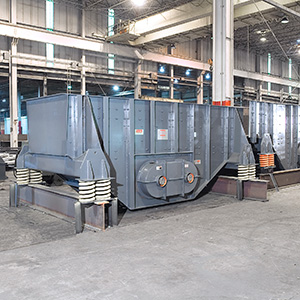
Posted on November 2nd, 2022 by Carrier Vibrating
FOUNDRY MANAGEMENT & TECHNOLOGY
McConway & Torley L.L.C., in Kutztown, PA, is a steel foundry specializing in couplers, yokes, strikers, drawbars, and other railcar components, which it supplies to the rail industry. McConway uses a Brunswick molding machine to produce 40x84x18/18-in. molds, at an average of 25 per hour, with a pour weight estimated at 2,100 lb per 1,600-lb. finished casting.
After each pour, castings are cooled in-mold on the pallet line and then transported to the shakeout system. The flasks are manually picked off the pallet line with a crane, and flipped over to rest on the shakeout frame. Then, the molds are knocked out of the flasks. The shakeout system separates the sand and castings where the castings are moved to the cleaning room.
Two Shakeouts, Various Problems
McConway had a series of problems with its shakeout operation, which was centered on two older two-mass natural-frequency shakeouts.
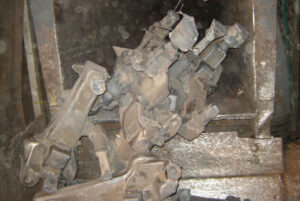
The first machine was installed to knock the molds out of the flasks. The shakeout machine was fitted with wooden rails to minimize damage to flasks. McConway invested a lot of money and maintenance time to replace its expensive springs, weld structural failures, and replace expensive vibratory motors. Also, due to the product’s heat, they had to replace the wooden rails every day. The machine was worn out and costing McConway too much to operate.
The second machine was designed for bulk sand removal. As with the first unit, it was a two-mass natural-frequency shakeout machine, just four years old, and it had been replaced in kind by the original machine. It was fitted with pneumatic airbags at the discharge end to elevate the shakeout and stop the flow of castings. Stopping the flow allows for additional retention time for the product, creating more sand removal.
McConway had several more problems with this system. First, the pneumatic airbags created additional retention time when needed, but they were one-dimensional: once the sand was removed, the castings would stay on the deck for a longer period of time. The operators had no way to “eject” the castings quickly, and as the castings remained there, the chances increased for damage to castings and wear to the deck.
The second problem is related more to safety. The drive for the shakeout was located overhead, and because there was no way to eject castings quickly, they tended to get stuck in the deck. This created log jams of castings and led to the operators shutting down the operation. Because the drive was overhead, workers had to use winches to extract castings — a very time-consuming and dangerous task.
The managers at McConway & Torley realized they needed to replace the out-of-date shakeout machines with a more modern and efficient shakeout system. Randy Schudalla, plant manager, sought a quote for a new shakeout system from Carrier Vibrating Equipment. In March 2006, Carrier’s foundry sales manager, Chuck Mitchell, proposed a solution that offered mechanical and process advantages: the patented Delta-Phase® shakeout.
Mechanical Advantages
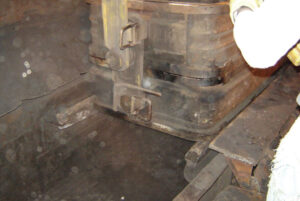
The Delta-Phase® shakeout uses direct-drive technology, a simple, heavy-duty design with long-life, spherical roller bearings, and eccentric weights to drive the system. The weights are connected with off-the-shelf foot-mounted motors and standard universal joints and are synchronized inertly, eliminating any need for special belts or gearboxes.
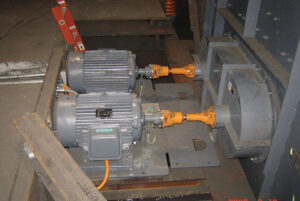
McConway & Torley operators had been familiar with two-mass natural frequency shakeouts, which incorporate multiple vibrating masses, forests of coil springs, and expensive vibratory motors. The only true benefit to this design is its lower horsepower, but it is a closely tuned system that is quite sensitive to any upset conditions or disruptions to a preventative maintenance program. Any upset, including sticking, jammed castings, overloading, and loose springs, can cause problems. These problems often result in overstroking, causing structural cracks and broken springs.
The direct-drive system is not tuned, so it is not sensitive to mass and speed changes or loose springs, all of which cause an “overstroke” condition. Overstroke is the leading cause of structural damage in vibratory equipment, and the fact that the Delta-Phase® shakeout will not overstroke due to its direct drive design was a great advantage for McConway & Torley.
Process Advantages
The real advantage of the Delta-Phase® is its simple and reliable electronics that allow the vibration angle to be changed. The variable change in vibration angle controls the conveying speed and retention time of the castings on the shakeout deck. This optimizes sand removal and minimizes casting damage and deck wear. The angle may be changed on the fly, and coupled with the control center of the foundry, if required. A wide range of casting types and sizes may be accommodated by using pre-programmed settings. Various castings can be pre-programmed to a multitude of recipes.
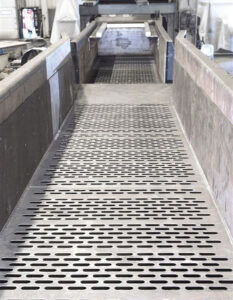
The pre-programmed panel has the versatility of using simple VFD and PLC technology to meet the specific shakeout requirement. The two most popular programs are the “stop-and-go” and continuous modes.
In stop-and-go mode, the angle of vibration is set at vertical once the mold reaches the desired location of the shakeout. Separation of sand from the casting and lump breakdown continues until the next mold approaches the shakeout. The angle of vibration changes to fast forward and the clean casting is discharged as the next mold arrives. In this mode, several molds may be retained on the shakeout for maximum retention time.
In continuous mode, the angle of vibration is set and maintained to provide the optimum retention time for the castings being produced. When a new casting is made, the angle of vibration is changed to its optimum angle.
New Shakeout System
Once McConway & Torley settled on Carrier Vibrating’s Delta-Phase® system, the installation was scheduled for August 2006. Carrier’s engineers worked closely with the foundry management and operators to address every aspect of both shakeouts and design the new installation properly.
The punch-out shakeout was designed to be 5 ft wide by 16 ft long. The original shakeout had the wooden rails that were replaced daily. Carrier had experience with a similar application using aluminum impact bars, which are soft enough not to inflict damage to the flasks, but sturdy enough to last much longer than a day, typically 6 to 12 months. These were fitted on the new shakeout.
The second shakeout is 5 ft wide by 25 ft long, and it is the real workhorse of the system. It receives molds from the first shakeout system, and must clean away much of the sand from the castings.
Both machines have heavy-duty 1.5-in. thick decks fabricated from AR 400 steel. In addition, the decks have been heavily stiffened to withstand impacts from 1,600-lb. steel castings.
Each deck is cut with back-drafted slots to maximize sand removal and minimize product jamming. The direct drives are located below the deck, so as not to interfere with the process flow. Sand is discharged directly to a sand hopper below.
Both units are driven by twin, 25-HP foot-mounted motors. Each has been outfitted with the Delta-Phase® controls, as well as a local recipe controller. These panels are located near the punch-out station and offer five pre-programmed recipes for different types of castings: program 1 is used for the castings that needed minimal retention time; program 5 is programmed for maximum retention time, which is a notable advantage for unpoured molds. (Three other programs are stepped between these two.) The recipe panel controls both shakeouts.
During the installation, Carrier supplied McConway & Torley with a service technician who oversaw the mechanical installation and trained the foundry’s operators to run the machinery properly. The technician was on-site during start-up to fine-tune the recipes.
Installing the new Carrier Delta-Phase® shakeout system allowed McConway & Torley to eliminate maintenance-intensive equipment and improve the sand-removal process. Shortly after the installation, foundry manager Jody Rahn confirmed, “this is one of the best decisions the company has made in the last twenty years.” With no significant maintenance to the machinery after more than a year of operation, that seems hard to dispute.
Download the Safer Shakeout Solves Production Problems article






